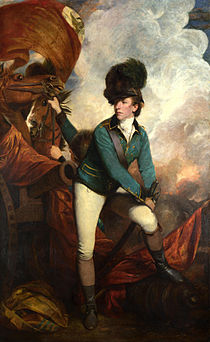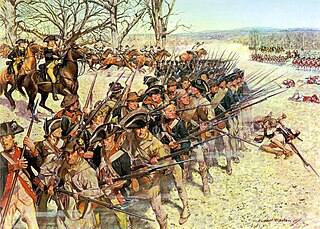
The Battle of Guilford Court House was on March 15, 1781, during the American Revolutionary War, at a site that is now in Greensboro, the seat of Guilford County, North Carolina. A 2,100-man British force under the command of Lieutenant General Charles Cornwallis defeated Major General Nathanael Greene's 4,500 Americans. The British Army, however, suffered considerable casualties.
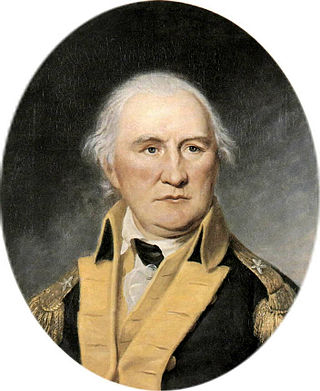
Daniel Morgan was an American pioneer, soldier, and politician from Virginia. One of the most respected battlefield tacticians of the American Revolutionary War of 1775–1783, he later commanded troops during the suppression of the Whiskey Rebellion of 1791–1794.

The Battle of Camden, also known as the Battle of Camden Court House, was a major victory for the British in the Southern theater of the American Revolutionary War. On August 16, 1780, British forces under Lieutenant General Charles, Lord Cornwallis routed the numerically superior American forces led by Major General Horatio Gates about four miles north of Camden, South Carolina, thus strengthening the British hold on the Carolinas following the capture of Charleston.
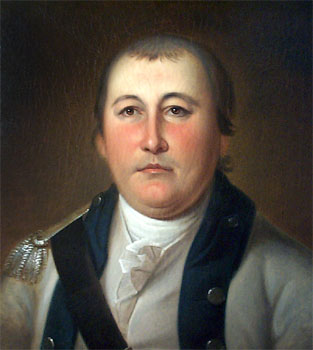
William Washington was a cavalry officer of the Virginia militia and Continental Army during the American Revolutionary War, who also served on General George Washington's staff during the naval war with France in 1798 and held a final rank of brigadier general. Primarily known as a commander of light dragoons, he led mounted troops in a number of notable battles in the Carolinas during the campaigns of 1780 and 1781. Following the conflict, this William Washington moved to South Carolina, where he married and served in the state legislature as well as led the Seventh Brigade of the South Carolina militia. Cavalry Commander William Washington of Stafford County and South Carolina has often been confused with his distant cousin William Augustine Washington, also a Revolutionary War patriot and planter, who served as a delegate representing Westmoreland County, Virginia.

Sir Banastre Tarleton, 1st Baronet was a British general and politician. He is best known as the lieutenant colonel leading the British Legion at the end of the American Revolutionary War. He later served in Portugal and held commands in Ireland and England.

The Battle of Kings Mountain was a military engagement between Patriot and Loyalist militias in South Carolina during the Southern Campaign of the American Revolutionary War, resulting in a decisive victory for the Patriots. The battle took place on October 7, 1780, 9 miles (14 km) south of the present-day town of Kings Mountain, North Carolina. In what is now rural Cherokee County, South Carolina, the Patriot militia defeated the Loyalist militia commanded by British Major Patrick Ferguson of the 71st Foot. The battle has been described as "the war's largest all-American fight".

The Battle of Cowpens was an engagement during the American Revolutionary War fought on January 17, 1781 near the town of Cowpens, South Carolina, between American Patriot forces under Brigadier General Daniel Morgan and British forces, nearly half American Loyalists, under Lieutenant Colonel Banastre Tarleton, as part of the campaign in the Carolinas. The battle was a turning point in the American reconquest of South Carolina from the British.

The Battle of Waxhaws was a military engagement which took place on May 29, 1780 during the American Revolutionary War between a Patriot force led by Abraham Buford and a British force led by Banastre Tarleton near Lancaster, South Carolina. Buford's men consisted of Continental Army soldiers, while Tarleton's force was mostly made up of Loyalist troops. After the two forces sighted each other, Buford rejected an initial demand to surrender. Tarleton's cavalrymen launched a charge against the Patriot troops, which led many of Buford's men to throw their arms down in surrender. However, as Tarleton was shot under his horse during the charge, his infuriated soldiers attacked their Patriot opponents, killing several.
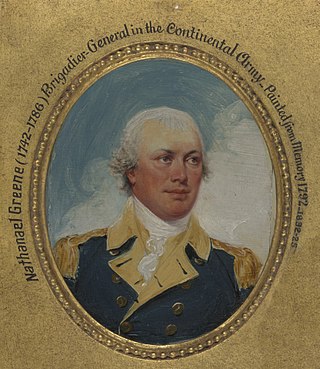
The Battle of Hobkirk's Hill was a battle of the American Revolutionary War fought on April 25, 1781, near Camden, South Carolina. A small American force under Nathanael Greene occupying Hobkirk's Hill, north of Camden, was attacked by British troops led by Francis Rawdon. After a fierce clash, Greene retreated, leaving Rawdon's smaller force in possession of the hill.
Pyle's Massacre,, was fought during the American Revolutionary War in present-day Alamance County on February 24, 1781. The battle was between Patriot troops attached to the Continental Army under Colonel Henry Lee and the Loyalist North Carolina militia commanded by Dr. John Pyle. Due to the unique uniform design of his forces, the Loyalists mistakenly thought Colonel Lee was the expected British cavalry commander, Banastre Tarleton, who was known to be en route to reinforce Pyle. When Lee's men opened fire, they took Pyle's force totally by surprise. This resulted in an extremely lopsided victory for Lee, and Pyle's command was scattered and routed.

The Loyal American Regiment was a British Provincial regiment raised in 1777 for Loyalist service during the American Revolutionary War. The regiment fought in many engagements throughout the war and the men were among the thousands of loyalists who settled in Nova Scotia, after the regiment disbanded in 1783.

The Battle of Charlotte was an American Revolutionary War battle fought in Charlotte, North Carolina on September 26, 1780. The battle took place at the Mecklenburg County Court House; which is now the site of the Bank of America tower at Trade and Tryon Streets in uptown Charlotte. An advance guard of General Charles Cornwallis' army rode into town and encountered a well-prepared Patriot militia under the command of William R. Davie in front of the court house. A skirmish ensued in which George Hanger, leading the British cavalry, was wounded. The small Patriot force, which had not intended more than token resistance, withdrew north toward Salisbury upon the arrival of Cornwallis and the main army.
The Battle of Monck's Corner was fought on April 14, 1780, outside the city of Charleston, South Carolina, which was under siege by British forces under the command of General Sir Henry Clinton in the American Revolutionary War. The Loyalist British Legion, under the command of Lieutenant Colonel Banastre Tarleton, surprised an American force stationed at Monck's Corner, and drove them away. The action cut off an avenue of escape for Benjamin Lincoln's besieged army. Aside from the British Legion, and the 33rd Foot and 64th Foot led by Lt. Col. James Webster, the force included Loyalists, the American Volunteers, led by Maj. Patrick Ferguson.
The Battle of Lenud's Ferry was a battle of the American Revolutionary War that was fought on May 6, 1780 in present-day Berkeley County, South Carolina. All of the British soldiers who took part in the Battle of Lenud's Ferry were in fact Loyalists who had been born and raised in the colony of South Carolina, with the sole exception being their commanding officer Banastre Tarleton. The unit was known as the Loyalist British Legion, under the command of Lieutenant Colonel Banastre Tarleton. The Loyalist British Legion scattered a company of Patriot militia at Lenud's Ferry, a crossing point on the Santee River, north of which lies present-day Georgetown County.

The Battle of Blackstock's Farm, an encounter of the American Revolutionary War, took place in what today is Union County, South Carolina, a few miles from Cross Anchor, on November 20, 1780.
The Battle of Wetzell's Mill was an American Revolutionary War battle fought on March 6, 1781, between detachments of Nathanael Greene's Continental Army and militia and Banastre Tarleton's Loyalist provincial troops in Guilford County, North Carolina.

Colonists who supported the British cause in the American Revolution were Loyalists, often called Tories, or, occasionally, Royalists or King's Men. George Washington's winning side in the war called themselves "Patriots", and in this article Americans on the revolutionary side are called Patriots. For a detailed analysis of the psychology and social origins of the Loyalists, see Loyalist.

The Battle of Torrence's Tavern was a minor engagement of the American Revolutionary War that took place in what was the western portion of Rowan County, North Carolina, approximately 10 miles (16 km) east of the Catawba River near modern-day Mooresville in Iredell County. Torrence's Tavern was a part of the larger Southern campaign of the American Revolution, which, by 1780–1781 involved a series of clashes between the British Army and Loyalist militia and the Continental Army and Patriot militia in the Piedmont region of North and South Carolina.

The British Army during the American Revolutionary War served for eight years in the American Revolutionary War, which was fought throughout North America, the Caribbean, and elsewhere from April 19, 1775 to September 3, 1783. The war formally commenced at the Battles of Lexington and Concord in present-day Massachusetts. Two months later, in June 1775, the Second Continental Congress, gathered in the revolutionary capital of Philadelphia, appointed George Washington to organize patriot militias into the Continental Army and lead them in a war against the British Army. The following year, in July 1776, the Second Continental Congress, representing the Thirteen Colonies, declared themselves free and independent from colonial governance.
